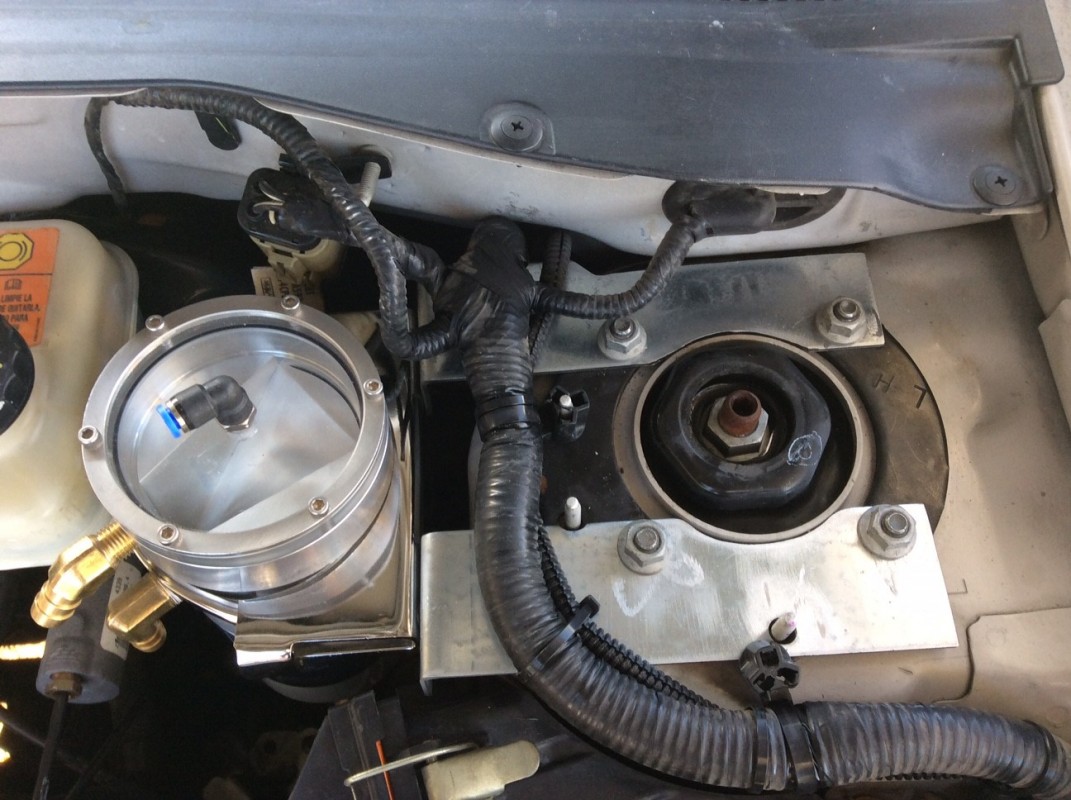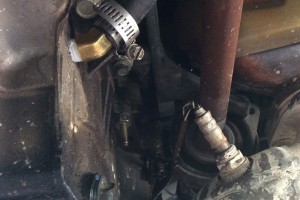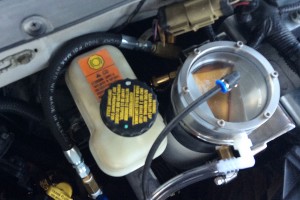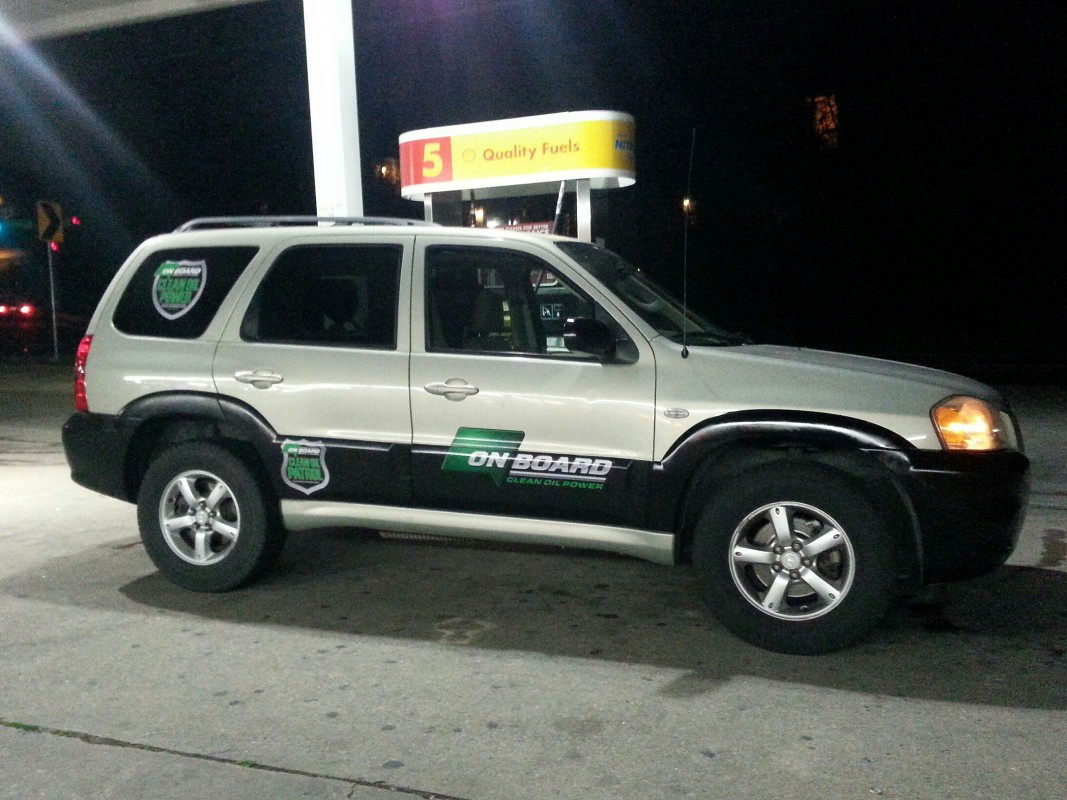ONBOARD® ECVD was originally designed with Diesel and Compressed Natural Gas (CNG), Internal Combustion Engines (ICE) in mind.
When I joined ONBOARD® in 2013, I often wondered what effect our ECVD LD-4 System would have on smaller gasoline ICE’s. In October of 2014, I installed an LD-4 on my 2005 Mazda Tribute with a DOHC V6 3.0 liter engine. I was going to find out.
At the time of installation of the ONBOARD® ECVD unit, the engine had 130,000 miles on her, with oil in the crankcase that was 5000 miles old and 5000 miles dirty.
I took an oil sample of the black, contaminated oil and sent it to Gearhead Labs, a third party, independent lab. I installed the ONBOARD® ECVD LD-4 unit with a very simple custom mount that bolted neatly to the four shock tower studs on the driver’s side right next to the brake master cylinder.

Mounting of ECVD
All the connections were simple save for the oil drain fitting that I mounted near the top and rear side of the oil pan. Some careful, slow drilling and even slower tapping had the fitting nicely placed in 15 or twenty minutes.

Oil pan fitting
I noticed an immediate increase in power when I drove it for the first time with the ECVD unit enabled. I had copious records of my fuel mileage before installing the LD-4 unit and on the first highway trip I saw an increase in MPG from 18.9 to 21.9!
Being blown away with the thought of actually getting nearly a 14% increase in efficiencies, I turned off the ball valve on the oil pressure line to the unit, disconnected the vacuum line and plugged off the crankcase vent line to the vacuum chamber. I then drove from Austin to Houston on the I-10 and saw the mileage drop right back to 18.9 mpg. On the way home I enabled the ONBOARD® unit and, you guessed it, the MPG went directly back to 21.9.
I did not stop there. Figuring the increase in power and MPG was attributed to the increase in combustion efficiencies, I wondered what the hydrocarbon emissions were reading with and without the ONBOARD® unit operating.
I went to Alan’s Inspection station near my home. I asked the nice young man working there if he would mind helping me with a little experiment if I bought him breakfast tacos. Needless to say, he obliged me immediately.
With a simple wand test up the tailpipe with the unit disabled, the reading was 6 ppm hydrocarbons at 2500 rpm. I then enabled the unit, let it run for several minutes then took another reading… 1 ppm hydrocarbons!
Before you call out, “Bull#@&%!”, I did the same test the next morning at another test station and got readings of 5 ppm without and 1 ppm with ECVD. I then went back to Alan’s and got 5 ppm without and 2 ppm with ECVD enabled. The outside temperature the second day was nearly 25 degrees colder that the first test day. That is a 60 to 84% decrease in hydrocarbons at the tailpipe.
All this took place in October of 2014. I ran that dirty oil that was in the crankcase through the ONBOARD® ECVD unit for another 7800 miles with everything running along nicely. In January, after driving round trip 3700 miles from Austin to Santa Barbara via Las Vegas, I took another oil sample.
The first oil analysis report for the 5000 mile old, dirty oil was over the warning limit of 15 ppm for Silicon (dirt), at 22 ppm. The oil oxidation was well over the 21% absorption warning level at 29.5%. The warning limit for water in the oil is .2%. My old, dirty, contaminated oil was at .1%, or halfway to the limit.
After driving this dirty oil for another 7800 miles through the unit, I took the second oil sample and as you can see here, the silicon dropped to 5ppm, the oxidation plummeted to 8.1%, and the water was completely eliminated from existence!
The oil in this picture is the same filthy, contaminated, oil that failed the initial oil analysis in October.

This oil had run for 5k miles before installing ONBOARD. After running with ONBOARD 12k miles, it looks like this.
Before you take my word for it, install an ONBOARD® ECVD on your engine and see for yourself what everyone else is experiencing. Better performance, better fuel efficiencies, lower emissions, greater DEF yield, less time in REGEN, less wear and tear on bearings and wear surfaces, and longer oil change intervals. All due to running with Clean Oil all the time, day after day, hour after hour…
This is the technology for which everyone has been searching.
Clean Oil Power. Clean Oil Performance. Clean Oil Destiny.
When I joined ONBOARD in 2013, I often wondered what effect our ECVD LD4 unit would have on smaller gasoline ICE’s. In October of 2014, I installed an LD4 unit on my 2005 Mazda Tribute with a DOHC V6 3.0 liter engine. I was going to find out.

Matt Dettman’s Mazda